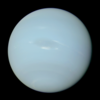Naiad (moon)
 Naiad or Thalassa as seen by Voyager 2 (elongation is due to smearing) | |
| Discovery | |
|---|---|
| Discovered by | Voyager Imaging Team |
| Discovery date | September 1989 |
| Orbital characteristics[1] | |
| Epoch 18 August 1989 | |
| 48 227 ± 1 km | |
| Eccentricity | 0.0004 ± 0.0003 |
| 0.2943958 ± 0.0000002 d | |
| Inclination |
|
| Satellite of | Neptune |
| Physical characteristics | |
| Dimensions | 96×60×52 km[2][3] |
| 33 ± 3 km[4] | |
| Volume | ~1.5×105km³ |
| Mass | ~1.9×1017 kg (based on assumed density) |
Mean density | ~1.3 g/cm³ (estimate)[4] |
| ~0.012 m/s2[a] | |
| ~0.028 km/s[b] | |
| synchronous | |
| zero | |
| Albedo | 0.07[2][4] |
| Temperature | ~51 K mean (estimate) |
| 23.9[4] | |
Naiad (/ˈneɪ.əd/ NAY-əd or /ˈnaɪ.əd/ NY-əd; Template:Lang-el), also known as Neptune III, is the innermost satellite of Neptune, named after the Naiads of Greek legend.[5]
History
Naiad was discovered sometime before mid-September 1989 from the images taken by the Voyager 2 probe. The last moon to be discovered during the flyby, it was designated S/1989 N 6.[6] The discovery was announced on September 29, 1989, in the IAU Circular No. 4867, but the text only talks of "25 frames taken over 11 days", giving a discovery date of sometime before September 18. The name was given on 16 September 1991.[7]
Physical characteristics

Naiad is irregularly shaped and probably has not been modified by any internal geological processes since its formation. It is likely that it is a rubble pile re-accreted from fragments of Neptune's original satellites, which were smashed up by perturbations from Triton soon after that moon's capture into a very eccentric initial orbit.[8]
Orbital characteristics
Naiad orbits about 23,500 km above Neptune's cloud tops. Since this is below the synchronous orbit radius, its orbit is slowly decaying due to tidal deceleration and it may eventually impact Neptune's atmosphere, or break up into a planetary ring upon passing its Roche limit due to tidal stretching. Naiad orbits Neptune well within its fluid Roche limit, and its density is expected to be low enough that it may be very close to its actual Roche limit already.[citation needed]
Exploration
Since the Voyager 2 flyby, the Neptune system has been extensively studied from ground-based observatories and the Hubble Space Telescope as well. In 2002–03 the Keck telescope observed the system using adaptive optics and detected easily the largest four inner satellites. Thalassa was found with some image processing, but Naiad was not located.[9] Hubble has the ability to detect all the known satellites and possible new satellites even dimmer than those found by Voyager 2. On October 8, 2013 the SETI Institute announced that Naiad had been located in archived Hubble imagery from 2004.[10] The suspicion that the loss of positioning was due to considerable errors in Naiad's ephemeris[11] proved correct as Naiad was ultimately located 80 degrees from its expected position.
Notes
- ^ Surface gravity derived from the mass m, the gravitational constant G and the radius r: Gm/r2.
- ^ Escape velocity derived from the mass m, the gravitational constant G and the radius r: √2Gm/r.
References
- ^
Jacobson, R. A.; Owen, W. M., Jr. (2004). "The orbits of the inner Neptunian satellites from Voyager, Earthbased, and Hubble Space Telescope observations". Astronomical Journal. 128 (3): 1412–1417. Bibcode:2004AJ....128.1412J. doi:10.1086/423037.
{{cite journal}}: Invalid|ref=harv(help)CS1 maint: multiple names: authors list (link) - ^ a b
Karkoschka, Erich (2003). "Sizes, shapes, and albedos of the inner satellites of Neptune". Icarus. 162 (2): 400–407. Bibcode:2003Icar..162..400K. doi:10.1016/S0019-1035(03)00002-2.
{{cite journal}}: Invalid|ref=harv(help) - ^ Williams, Dr. David R. (2008-01-22). "Neptunian Satellite Fact Sheet". NASA (National Space Science Data Center). Retrieved 2008-12-13.
- ^ a b c d "Planetary Satellite Physical Parameters". JPL (Solar System Dynamics). 2008-10-24. Retrieved 2008-12-13.
- ^ "Planet and Satellite Names and Discoverers". Gazetteer of Planetary Nomenclature. USGS Astrogeology. July 21, 2006. Retrieved 2006-08-05.
- ^ Green, Daniel W. E. (September 29, 1989). "Neptune". IAU Circular. 4867. Retrieved 2011-10-26.
- ^ Marsden, Brian G. (September 16, 1991). "Satellites of Saturn and Neptune". IAU Circular. 5347. Retrieved 2011-10-26.
- ^
Banfield, Don; Murray, Norm (October 1992). "A dynamical history of the inner Neptunian satellites". Icarus. 99 (2): 390–401. Bibcode:1992Icar...99..390B. doi:10.1016/0019-1035(92)90155-Z.
{{cite journal}}: Invalid|ref=harv(help) - ^
Marchis, F.; Urata, R.; de Pater, I.; Gibbard, S.; Hammel, H. B.; Berthier, J. (May 2004). "Neptunian Satellites observed with Keck AO system". American Astronomical Society, DDA meeting #35, #07.08; Bulletin of the American Astronomical Society. Vol. 36. p. 860. Retrieved 2006-08-05.
{{cite conference}}: Unknown parameter|booktitle=ignored (|book-title=suggested) (help) - ^ "Lost Neptune Moon Re-Discovered". Retrieved 9 October 2013.
- ^
Showalter, M. R.; Lissauer, J. J.; de Pater, I. (August 2005). "The Rings of Neptune and Uranus in the Hubble Space Telescope". American Astronomical Society, DPS meeting #37, #66.09; Bulletin of the American Astronomical Society. Vol. 37. p. 772. Retrieved 2006-08-05.
{{cite conference}}: Unknown parameter|booktitle=ignored (|book-title=suggested) (help)
External links
- Naiad Profile by NASA's Solar System Exploration
- Neptune's Known Satellites (by Scott S. Sheppard)
- Archival Hubble Images Reveal Neptune's “Lost” Inner Moon (SETI : October 8, 2013)



